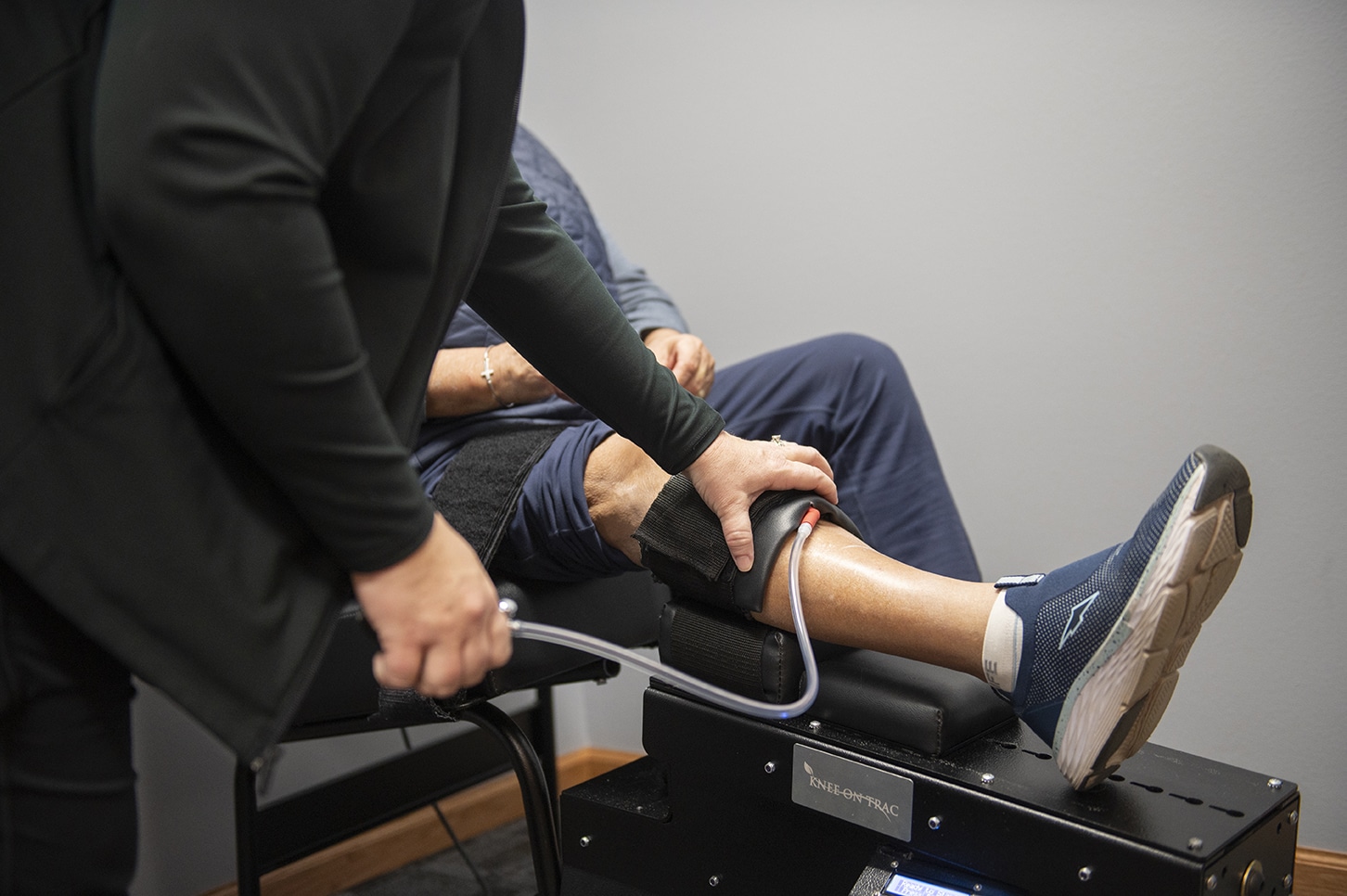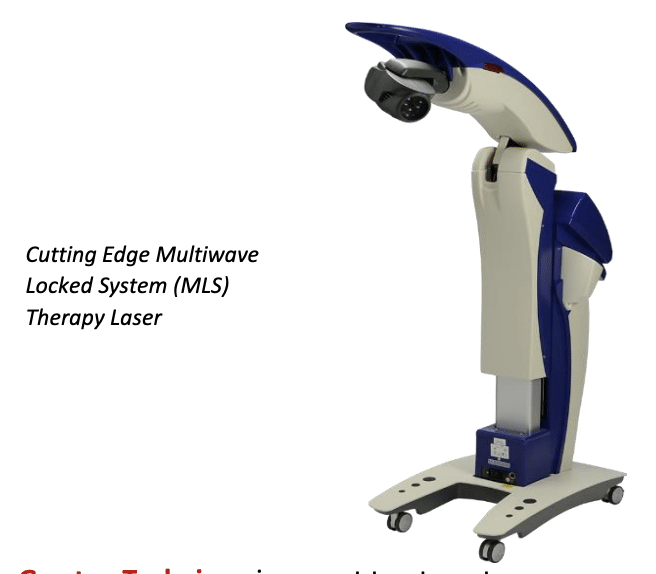This free report was written by Kyle J. Pankonin, DC, DIANM, DACCP, CFMP, CCEP, a board-certified chiropractic orthopedist with nearly two decades of clinical experience treating some of the most challenging pain conditions in the human body, including knee pain due to osteoarthritis. This training in orthopedics allows him properly diagnose what the cause of the knee pain is and offer research-based, non-drug and non-surgical options.
LIVING WITH KNEE PAIN
I want to start this report by addressing the suffering and fears you likely are experiencing if you are living with knee pain. It makes walking painful, and it can threaten your livelihood if you are on your feet a lot. Having knee pain can cause you to limp, which affects the joints above, like the hip and lower back. It can limit your ability to exercise, which can lead to weight gain and put you at risk for heart and other health issues. Knee pain and arthritis symptoms are life-changing, and many people suffer greatly from aching, stiffness, pain with walking, limping and avoiding activities they enjoy.
While there are no absolute guarantees in healthcare, for many of you reading this guide there is hope for significant and meaningful improvement to your condition. There are advanced research-based non-drug and non-surgical options now being used throughout the United States. These are options your traditional doctor will not tell you about. There are ways to promote cartilage healing, lessen inflammation, and improve range of motion and function. Better sleep, less pain while walking, and better quality of life is possible for many people currently suffering from knee pain.
Let’s talk about:
- What causes knee pain
- How modern medicine approaches this problem
- Different types of knee pain
- Alternative treatments that work
- How to determine if you are a good candidate for alternative types of treatment
CAUSES
The most common cause of knee pain in those aged 65 and older is osteoarthritis. This is arthritis mostly due to wear and tear and chronic inflammation that breaks down the cartilage lining in the knee joint. As this cushion is lost and the bones come closer together, pain will often occur once it reaches a certain threshold of degeneration. People who have this many times, but not always, report some old injury earlier in life. Many people that develop pain on the inner side of the knee due to arthritis have imbalances and arch problems in their feet that are a potential cause of the subsequent knee problem.
Another common cause of knee pain in athletes and more middle-aged people is a meniscus tear, which is where the cartilage lining of the knee is. The often results from an injury, but also can develop gradually in some people due to wear and tear and stress on the knee from certain occupations. Sprains and strains are caused by injuries common to athletes or from slips and falls. A proper examination is necessary to determine what has been injured and what the extent of the injury is. Sometimes, because of an incorrect diagnosis or improper treatment or advice, these injuries can become chronic, causing daily pain that doesn't seem to go away.
Yet another common cause is bursitis or tendonitis. These usually develop from acute injuries, repetitive strains, or faulty foot alignment. Often there is some degree of inflammation in the involved tendon or bursa, which is sometimes visible to the naked eye. Finally, a condition called osteochondritis dessicans can be a cause of knee pain. It is a knee joint condition in which bone underneath the cartilage of a joint dies due to lack of blood flow. This bone and cartilage can then break loose, causing pain and possibly hindering joint motion. This condition occurs most often in children and adolescents. It can cause symptoms either after an injury or after several months of activity, especially high-impact activity, such as jumping and running, that affects the joint.
MEDICAL TREATMENT OPTIONS
Medical treatment options fall under what we call the "drug it, numb it, cut it" approach. The first line of treatment will usually involve some type of over-the-counter or prescription-strength painkiller or anti-inflammatory. These certainly can provide symptomatic relief, but they can also produce some considerable side effects, including bleeding ulcers, kidney damage, liver damage and an acceleration of the degenerative process. Yes, you read that right, these drugs have been shown in studies to actually speed up the degenerative process. Also, studies show in the case of injury taking these medications beyond the first few days actually slows the healing process considerably.
Clearly the "drug it" approach is not a good long-term option. If and when this fails to produce enough relief, then typically an injection will be tried. This usually involves a steroid shot or possibly a Synvisc injection to try to lubricate the cartilage. These approaches can relieve pain for days, weeks and even sometimes months, but eventually the relief wears off, especially if the underlying problem causing the pain is not addressed. Frequently repeat injections will be tried until they fail to provide further relief. Just as in the case of the drugs, shooting cortisone into joints actually speeds up the process of degeneration and can cause tissue destruction and break down, so the "numb it" approach too is not a good option long term.
Finally, when the drugs and shots no longer work, a surgical (cut it) option is offered. Total knee replacement utilization in the United States more than doubled from 1999 to 2008. Certainly in some cases of knee pain this may be the only option that may help, but it also comes with considerable risks and downtime while healing.
ALTERNATIVE TREATMENT OPTIONS
There is no one magic bullet for treating knee pain. It takes a comprehensive approach to find and address the cause and then to correct or at least improve the damage that has occurred.
IN-OFFICE TREATMENTS THAT WORK
- Knee On Trac is a state-of-the-art traction device that allows for non-surgical mechanical traction to the knee. Traction provides a gentle way to induce separation in the joint, which can relieve pressure on the meniscus, allow better circulation, and has been shown to stimulate healing in the cartilage. When a knee joint is degenerated and the bones are closer together, traction provides a gentle, soothing distraction to the joint. It feels good and is very relieving of pressure in painful arthritis or injured knees. Traction is one of the best treatment options available, especially for arthritis knees. It has been shown in studies to be osteogenic (stimulates bone health), angiogenic (stimulates blood flow), and promotive of visco-elastic changes (molecular rearrangement).
- MLS Laser Therapy is a class IV laser and is the most powerful available on the market for treating knee pain. We are the only clinic in our area with such an advanced laser. It is totally painless, and has been shown in numerous studies to reduce pain, reduce inflammation, and stimulate healing in injured and painful knee joints. The laser uses two different wavelengths: one works on pain and one works on inflammation. They are synced together to produce a synergistic effect. This powerful therapy can be used on all knee conditions and sometimes is combined with Knee On Trac traction therapy.
- Chiropractic adjustments and custom orthotics can help correct misalignments in the joints of the knee and help to improve range of motion. Improving joint alignment and motion is crucial in helping to resolve many knee pain conditions. Our staff's additional training allows us to know which joints need to be treated and how to do it in very precise and gentle manner. Many alignment issues in the knee are caused by faulty balance and alignment in the feet. This is the most overlooked cause of knee pain. We perform digital foot scans of both feet with our state-of-the-art Foot Levelers kiosk. It provides accurate readings of the foot arches, balance and alignment. From these precise foot scans, custom orthotics can be designed to address the faulty alignment in the feet. When foot alignment is improved, the joints above, including the knees, are many times helped.
- Targeted supplementation for natural anti-inflammatory support can be prescribed. We utilize an exciting and well-researched supplement called Joint Complex. The ingredients contained in this supplement help to regrow joint cartilage, replace fluid in the joints, relieve pain or stiffness and improve mobility. The dosage is only one capsule per day which makes it easy for people to take. Over time this can help to reduce or eliminate the need for much riskier prescription and over-the-counter anti-inflammatories.
CAN YOU BE HELPED?
After conducting a thorough health history review and physical examination we will be able to tell you if you are a good candidate for this type of care or not. We will be honest with you. Our goal is to reduce your symptoms by a minimum of 50% or more.
ARE YOU READY?
Your options are to do nothing and live with the pain, try drugs, shots or surgery, or try a good non-drug and non-surgical option such as we have outlined in this report. If you are ready for an advanced, state-of-the-art non-drug and non-surgical option, we can provide that. We look forward to helping you to achieve better health.
Knee Program Frequently Asked Questions
Our program is right for chronic knee pain, osteoarthritis, ACL injuries, meniscus tear, failed surgery, sub-acute muscle strain, chronic muscle strain and previous knee injuries.
The best dosage is 24 sessions spread out over a 3 month period: 3 times per week the first month, 2 times per week the second month and 1 time per week the third month. This gives the cartilage an adequate amount of time to heal as much as possible. Studies have shown this to be the best recommendation.
You should plan on 30-45 minutes per session.
It is a comprehensive program that utilizes Knee On Trac traction therapy, MLS laser therapy, custom orthotics from Foot Levelers, chiropractic adjustments and nutritional support supplements. The total cost will range from $2,400-3,500 over 3 months, depending on your specific needs. We have several payment plans available.
If after reviewing your history and examining you we determine you are a good candidate, then your chances of significant relief are 85-90%. This program works for most people, and other doctors around the country who use similar programs report this level of success as well.
Some insurances cover chiropractic adjustments to the extremities (non-spine). Medicare does not. Knee On Trac traction, MLS laser therapy, custom orthotics from Foot Levelers and supplements are not covered by insurance and will not be billed.
Nothing in healthcare is guaranteed, but a good candidate who follows the program as outlined has an 85-90% chance of very significant relief.
Take control of your health today!
Schedule your initial consultation with our experienced team now and start your journey towards a pain-free life.


